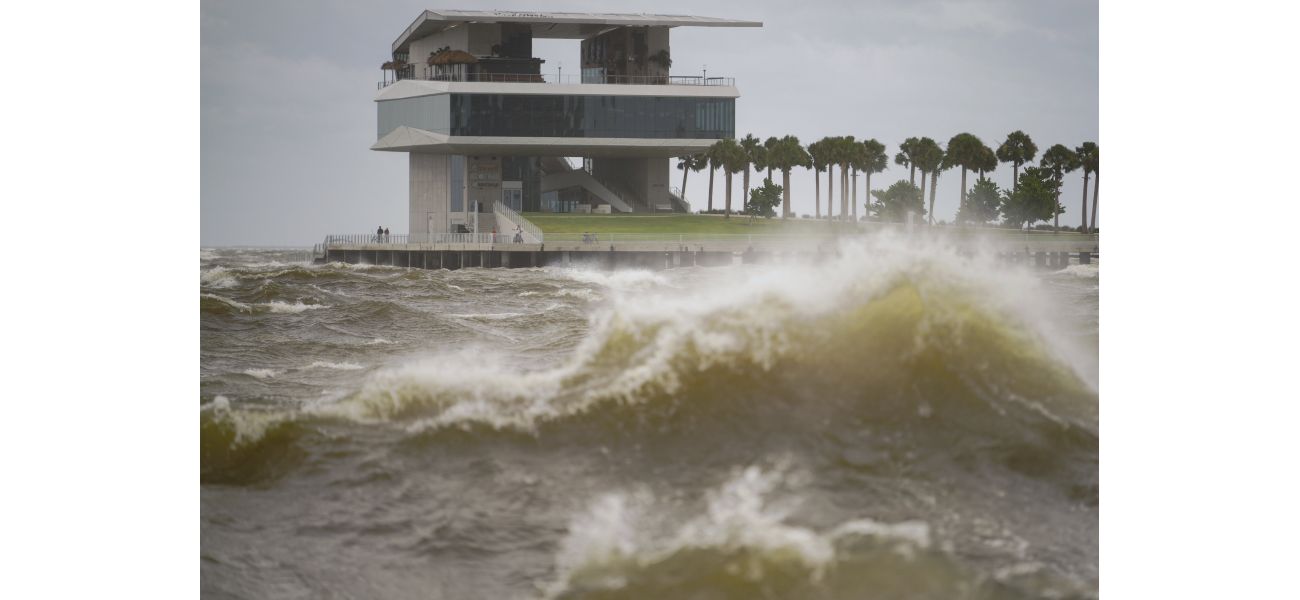Helene intensifies to a Category 4 storm as it approaches the Gulf Coast of Florida.
Many states have declared emergencies due to strong winds causing power outages for over 250,000 properties.
September 26th 2024.

Last night, Helene, a powerful Category 4 hurricane, gained strength and was expected to make landfall earlier than predicted on Florida's northwest coast. The storm's immense size and strength had forecasters issuing warnings of a potentially catastrophic storm surge and dangerous winds and rain throughout the southeastern US.
A Category 4 hurricane has sustained winds over 130 miles per hour, which can cause significant damage to homes, trees, and power lines. In fact, the strong winds have already knocked out power to over 250,000 homes and businesses in Florida, according to the tracking site poweroutage.us.
Helene was located about 60 miles west of Tampa and had sustained winds of 135 miles per hour, according to the US National Hurricane Center. The storm was expected to bring life-threatening storm surges of up to 20 feet in the Big Bend area of Florida. As a result, hurricane warnings and flash flood warnings extended well beyond the coast, reaching as far as northern Georgia and western North Carolina.
In preparation for the storm, the governors of Florida, Georgia, the Carolinas, and Virginia have all declared states of emergency. This is not the first time Florida's Big Bend has faced a major hurricane. Just last year, Hurricane Idalia slammed into the same area, causing widespread damage. Idalia had also reached Category 4 status in the Gulf of Mexico before making landfall as a Category 3 near Keaton Beach.
Already, the effects of Helene can be felt, with water covering roads and intersections along Florida's Gulf Coast and debris from a recent fire in Cedar Key washing ashore. Additionally, winds of up to 130 miles per hour have left around 180,000 homes and businesses without power in Florida.
But the impact of Helene is not limited to just Florida. In North Carolina, up to 10 inches of rain has fallen in the mountains, and forecasters predict that up to 14 more inches could fall before the storm passes. This could lead to flooding that could be worse than anything seen in the past century.
Florida Governor Ron DeSantis announced yesterday morning that the storm's path has shifted slightly, which means the capital city of Tallahassee may not experience a direct hit as originally predicted. However, the storm is now headed towards the sparsely populated Big Bend area, which is home to fishing villages and vacation spots where the Panhandle and peninsula meet.
As the storm approaches, the sheriff's office in Taylor County is urging those who chose not to evacuate to write their names, birthdays, and important information on their arms or legs in permanent marker. This will help identify them and notify their families in case of emergency. This advice is similar to what other officials have given during past hurricanes.
However, many people are heeding the mandatory evacuation orders, which stretch from the Panhandle to the Gulf Coast in low-lying areas around Tallahassee, Gainesville, Cedar Key, Lake City, Tampa, and Sarasota. Among those evacuating is Sharonda Davis, who is worried that her mobile home won't withstand the storm's strong winds.
Sharonda is not alone in her fears. The hurricane's size is what's most alarming to many, as it could cause widespread destruction and devastation in its aftermath. Federal authorities are already staging search-and-rescue teams, as the National Weather Service in Tallahassee warns of potential catastrophic and unsurvivable storm surges of up to 20 feet in Apalachee Bay.
School districts and universities along Florida's Gulf Coast have canceled classes, and airports in Tampa, Tallahassee, and Clearwater are closed. Cancellations are also widespread in other parts of the state and beyond. Although Helene is expected to weaken as it moves inland, damaging winds and heavy rain are still a concern, and the southern Appalachian Mountains could experience landslides.
The center advises that the region could experience prolonged power outages and flooding, and Tennessee is one of the states expected to be hit hard. Helene has already caused significant damage in other parts of the world, as it swamped Mexico's Yucatan Peninsula and knocked out power to over 200,000 homes and businesses in western Cuba.
But Helene is not the only storm in the Atlantic. Tropical Storm Isaac formed on Wednesday and is expected to strengthen as it moves eastward across the open ocean, possibly becoming a hurricane by the end of the week. It could affect parts of Bermuda and eventually the Azores by the weekend. And in the Pacific, former Hurricane John has reformed as a tropical storm and strengthened back into a hurricane, threatening areas of Mexico's western coast with flash flooding and mudslides.
As the storm approaches and people brace for its impact, many are reminded of past hurricanes that have caused destruction and devastation. In the Gulf Coast, schools and universities have canceled classes, and airports have shut down. And in Georgia, more than half of the state's public school districts have canceled classes, and overnight curfews have been imposed in many cities and counties.
Governor Brian Kemp has also authorized up to 500 National Guard soldiers to assist with the storm. For Atlanta, Helene could be the worst strike on a major Southern inland city in 35 years, according to University of Georgia meteorology professor Marshall Shepherd.
Helene is the eighth named storm of the Atlantic hurricane season, which began on June 1. The National Oceanic and Atmospheric Administration has predicted an above-average hurricane season this year due to record-warm ocean temperatures.
The potential for widespread destruction and devastation is a reminder of the power of nature and the importance of being prepared for these types of events. As Helene continues on its path, it is crucial to heed evacuation orders and take all necessary precautions to ensure safety.
A Category 4 hurricane has sustained winds over 130 miles per hour, which can cause significant damage to homes, trees, and power lines. In fact, the strong winds have already knocked out power to over 250,000 homes and businesses in Florida, according to the tracking site poweroutage.us.
Helene was located about 60 miles west of Tampa and had sustained winds of 135 miles per hour, according to the US National Hurricane Center. The storm was expected to bring life-threatening storm surges of up to 20 feet in the Big Bend area of Florida. As a result, hurricane warnings and flash flood warnings extended well beyond the coast, reaching as far as northern Georgia and western North Carolina.
In preparation for the storm, the governors of Florida, Georgia, the Carolinas, and Virginia have all declared states of emergency. This is not the first time Florida's Big Bend has faced a major hurricane. Just last year, Hurricane Idalia slammed into the same area, causing widespread damage. Idalia had also reached Category 4 status in the Gulf of Mexico before making landfall as a Category 3 near Keaton Beach.
Already, the effects of Helene can be felt, with water covering roads and intersections along Florida's Gulf Coast and debris from a recent fire in Cedar Key washing ashore. Additionally, winds of up to 130 miles per hour have left around 180,000 homes and businesses without power in Florida.
But the impact of Helene is not limited to just Florida. In North Carolina, up to 10 inches of rain has fallen in the mountains, and forecasters predict that up to 14 more inches could fall before the storm passes. This could lead to flooding that could be worse than anything seen in the past century.
Florida Governor Ron DeSantis announced yesterday morning that the storm's path has shifted slightly, which means the capital city of Tallahassee may not experience a direct hit as originally predicted. However, the storm is now headed towards the sparsely populated Big Bend area, which is home to fishing villages and vacation spots where the Panhandle and peninsula meet.
As the storm approaches, the sheriff's office in Taylor County is urging those who chose not to evacuate to write their names, birthdays, and important information on their arms or legs in permanent marker. This will help identify them and notify their families in case of emergency. This advice is similar to what other officials have given during past hurricanes.
However, many people are heeding the mandatory evacuation orders, which stretch from the Panhandle to the Gulf Coast in low-lying areas around Tallahassee, Gainesville, Cedar Key, Lake City, Tampa, and Sarasota. Among those evacuating is Sharonda Davis, who is worried that her mobile home won't withstand the storm's strong winds.
Sharonda is not alone in her fears. The hurricane's size is what's most alarming to many, as it could cause widespread destruction and devastation in its aftermath. Federal authorities are already staging search-and-rescue teams, as the National Weather Service in Tallahassee warns of potential catastrophic and unsurvivable storm surges of up to 20 feet in Apalachee Bay.
School districts and universities along Florida's Gulf Coast have canceled classes, and airports in Tampa, Tallahassee, and Clearwater are closed. Cancellations are also widespread in other parts of the state and beyond. Although Helene is expected to weaken as it moves inland, damaging winds and heavy rain are still a concern, and the southern Appalachian Mountains could experience landslides.
The center advises that the region could experience prolonged power outages and flooding, and Tennessee is one of the states expected to be hit hard. Helene has already caused significant damage in other parts of the world, as it swamped Mexico's Yucatan Peninsula and knocked out power to over 200,000 homes and businesses in western Cuba.
But Helene is not the only storm in the Atlantic. Tropical Storm Isaac formed on Wednesday and is expected to strengthen as it moves eastward across the open ocean, possibly becoming a hurricane by the end of the week. It could affect parts of Bermuda and eventually the Azores by the weekend. And in the Pacific, former Hurricane John has reformed as a tropical storm and strengthened back into a hurricane, threatening areas of Mexico's western coast with flash flooding and mudslides.
As the storm approaches and people brace for its impact, many are reminded of past hurricanes that have caused destruction and devastation. In the Gulf Coast, schools and universities have canceled classes, and airports have shut down. And in Georgia, more than half of the state's public school districts have canceled classes, and overnight curfews have been imposed in many cities and counties.
Governor Brian Kemp has also authorized up to 500 National Guard soldiers to assist with the storm. For Atlanta, Helene could be the worst strike on a major Southern inland city in 35 years, according to University of Georgia meteorology professor Marshall Shepherd.
Helene is the eighth named storm of the Atlantic hurricane season, which began on June 1. The National Oceanic and Atmospheric Administration has predicted an above-average hurricane season this year due to record-warm ocean temperatures.
The potential for widespread destruction and devastation is a reminder of the power of nature and the importance of being prepared for these types of events. As Helene continues on its path, it is crucial to heed evacuation orders and take all necessary precautions to ensure safety.
[This article has been trending online recently and has been generated with AI. Your feed is customized.]
[Generative AI is experimental.]
0
0
Submit Comment





